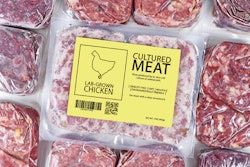
Demand for chicken meat in Asia will continue its growth trajectory, possibly reaching up 154 million metric tons by 2031, and could overtake pork as the number one protein in the region.
“The poultry sector has tremendous potential,” said Pelayo Casanovas, Vice President – EMEA and APAC with Cobb-Vantress, speaking at Poultry International’s Global Poultry Trends – Their Impact on the Southeast Asian Broiler Meat and Egg Markets, held at VIV Asia earlier this month.
“The forecast for poultry meat consumption is projected growth of 16% over the next eight years, another 21 million metric tons, which is a tremendous amount of output of poultry.”
During his talk, Casanovas looked at both the macro and consumer trends influencing broiler production.
4 trends driving growth in Asian poultry production
Poultry meat will account for nearly 50% of all meat consumption in Asia by 2031. According to Casanovas, four factors are driving this expansion:
- Population growth: The global population continues to rise. While that rate has slowed, including in Asia, there will still be significantly more people. For example, in Asia, there were 22 million people born last year, and, as Casanovas said, they will hopefully eat more chicken.
- Urbanization: Today, 52% of the Asian population lives in urban areas. This will rise to 70% by 2050. “As soon as people move into the cities, they have more opportunities, more buying power and then they consume more protein, more meat,” Casanovas said.
- Market-share to claim: Per capita chicken meat Asia is still low. “Asian chicken consumption is low, less than 10 kilos per capita, so there is potential for growth,” he noted.
- Increased buying power: While Western economies will grow by less than 2%, many Asian countries could see growth anywhere from 4% to 7% in the coming years. “From that perspective, more buying power means more consumption of meat up to a certain level,” he said.
Changes in slaughter weights
Traditionally, the Asia-Pacific region produces smaller birds, with about 40% of chickens being processed weighing less than two kilograms. However, Casanovas reports a shift toward bigger birds, mostly driven by China, moving from 2.5 kilograms to almost 3 kilograms in some cases and in India from 2 kilograms to 2.5 kilograms.
“Even if it's slow, there’s always a tendency for most markets to try to process bigger birds,” he said. “As soon as they get better control over disease, or they have better buying power, they'll try to process bigger chickens because it's more efficient.”
Processing trends
In Asia-Pacific, almost 40% of the birds are still sold live.
“They prefer either to buy the chicken live in the market or to cut it up and process it and sell it or eat it in small amounts combined with other food,” Casanovas explained.
The decline in live markets will not necessarily boost demand for whole birds, Rather, it will lead more towards deboning and eventually further processing. Currently, however, only 14% of birds in the Asia Pacific are deboned, versus 53% in North America.
In many parts of the region there is a preference for dark meat. In Northeast Asia, China, Japan and Korea, for example, these markets have a strong preference for dark meat, which is reflected in the price.
China is, however, making efforts to use more breast meat in products, making better use of the whole bird and thus reducing the price difference between dark and white meat.
Given regional variation, where supply of broilers is concerned, it is not possible to work with the same type of bird in every region.
“You really need to tailor it to different parts of the world,” Casanovas explained. “We have breeding programs in North America, in Europe, and in India, that are radically different in terms of how we select the birds, and we really tailor the products to the needs of different markets across the world.”
4 challenges impacting poultry production
Casanovas went on to detail four key factors that will continue to challenge global poultry production:
- Highly pathogenic avian influenza (HPAI): The recent epidemic has been the worst on record, has been extremely virulent and has not adhered to typical seasonality. Vaccination strategies remain highly debated, but the disease will not going away. Standard biosecurity measures will no longer be enough to mitigate the risk.
- Animal welfare trends: HPAI-related deaths and culling may become a welfare concern, while in the European Union proposed broiler management changes will make production particularly difficult.
- Land availability: In Asia, land availability is a serious problem, with high costs impacting ability to house birds. In the end, producers will have to produce more with less through genetics and technology.
- Labor shortages: Global trend will result in more automation, robotics and the leveraging of data to inform smart decision making.

















